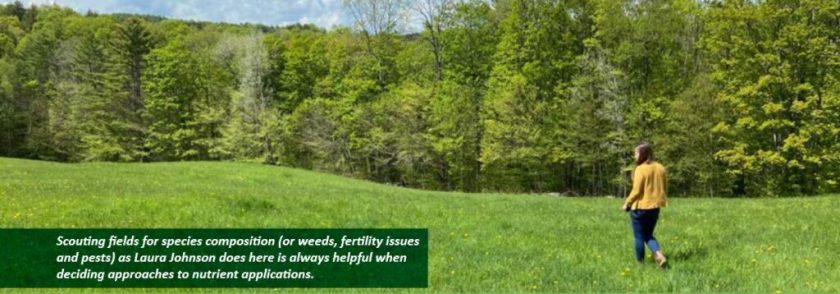By Kirsten Workman, Agronomy Specialist
This article was originally printed as part of our Fall-Winter 2020 Newsletter.
In the Champlain Valley, we spend a lot of time and effort managing phosphorus (P). Rightfully so, as it is the pollutant behind algae blooms in Lake Champlain. Our clay soils often bind to it tightly, making it less available to plants when they need it most, and it isn’t perfectly balanced with crop needs in our manure applications. All of this makes it a tricky nutrient to manage. However, we have taken our eye off another primary macronutrient as a result.
Nitrogen (N)
Nitrogen is the dominant macronutrient in agriculture. While it hasn’t had top billing here lately, it is probably the most important and studied nutrient from a crop production standpoint. Without adequate nitrogen, yield and quality can be compromised. Nitrogen drives vegetative growth and protein content, having a direct correlation with forage value in livestock systems and nutrition in food crops. In watersheds where the receiving surface waters are marine (e.g., the Connecticut River which drains to Long Island Sound, or the Mississippi River which drains into the Gulf of Mexico), nitrogen causes water quality issues like eutrophication and algae blooms – the same problems that phos-phorus causes in Lake Champlain. Generally, N is much more mobile than P in soil. Because of this, it is often prone to loss. The primary pathways for N loss are:
• Volatilization – N turns into ammonia gas and dissipates into the atmosphere. (Applying nitrogen when temperatures are cool, a light rain is expected to facilitate incorporation, or by physically mixing it with the soil can reduce volatilization risk. Nitrogen stabilizers can also inhibit this reaction.)
• Denitrification – Occurs in saturated soil conditions when nitrate turns into N2 and N2O gas. (Good soil drainage, high soil organic matter and proper pH, split N applications and nitrogen stabilizers can help prevent excessive denitrification.)
• Runoff – Carries nitrogen from manure, fertilizer and eroded soil off the field into ditches, creeks, rivers and streams. (Field buffers, reducing erosion, properly timed nutrient applica-tions can reduce N runoff.)
• Leaching – When N can’t attach to soil particles or be taken up by plants, it easily leaches downward with soil water toward groundwater and even out tile drain outlets. This is much more common in sandier soils that do not have the water holding capacity of heavier soils like clay and loam. (Applying manure and nitrogen fertilizer during the growing season, proper nutrient management, avoiding fall-killed sod, and utilizing cover crops to increase nutrient uptake can decrease the amount of N leaching.)
A primary reason nitrogen is analyzed so much, is that farms can often see immediate impacts from over or underutilizing nitrogen. In addition, good N management can also save a farm a significant amount of money in fertilizer savings. This often gets overlooked when N prices are low (as they have been recently), and farms are prone to “insurance applications” of N to make sure they aren’t shorting their crops. With prices averaging between $0.28 to $0.41 per pound of N¹ (depending on the type of fertilizer), it can seem like a cheap way to ensure good yields and quality. However, in a time of tight margins and increasing environmental regulation this can be an unsustainable way to operate. And if you are an organic producer, the $3 to $5 per pound cost of N fertilizer means you probably already understand the value of farm-produced nitrogen, and being as efficient as possible with those homegrown and purchased sources of N². In 2018, Vermont agricultural producers utilized almost 10,000 tons of nitrogen fertilizer, with another 7,000 tons of multi-nutrient fertilizers that likely had some portion of nitrogen³. In comparison, during this same time period, 15 tons of phosphate fertilizer was sold for agricultural use.
In the coming months, we’ll dig deeper into the world of nitrogen and see where we can do a better job providing our crops with adequate nitrogen without breaking the bank or causing unintended environmental consequences. We will consider:
– Corn and Nitrogen: Managing N in corn silage crops and how do we know if we’ve overdone N applications? A Caring Dairy Prove-It Project case study on Corn and Nitrogen.
– Managing N in hay and pasture crops and letting nature pay your fertilizer bill.
– Manure and N management – how do we make the most of the nitrogen in our manure?
– HomegrowN – taking credit for all the nitrogen on your farm, not just the stuff you purchase outright.
If you have a question about N fertilizer or manure management you can also contact Kirsten at kirsten.workman@uvm.edu.
One tool available to producers to evaluate N management strategies is the Corn Stalk Nitrate Test (CSNT), seen here on the Gosliga Farm (Addison, Vt.). It is designed to be a report card assessment at the end of the season to help modify and improve N management strategies on the farm in future years. The CSNT is a useful tool that indicates whether the nitrogen supply for that year was low, marginal, optimal, or in excess of what the corn needed this year. Corn that has received inadequate N will remove N from the lower cornstalk and leaves during the grain filling period. Plants that have received more N than needed to attain maximum yields tend to accumulate nitrate-N in the lower stalks at the end of the season.
Citations:
¹ August 2020 (Progressive Farmer by DTN), https://www.dtnpf.com/agriculture/web/ag/crops/article/2020/08/12/fertilizer-prices-remain-lower-first
² Organic N price based on estimated costs of bulk sodium nitrate (a.k.a. Chilean nitrate)
³ VAAFM, 2018-2019 Vermont Fertilizer Analysis Report https://agriculture.vermont.gov/sites/agriculture/files/documents/PHARM/Fertilizer/Annual%20Report%20Fertilizer%202018-2019.pdf
RESOURCES: https://extension.missouri.edu/publications/wq252 http://cceonondaga.org/resources/nitrogen-basics-the-nitrogen-cycle








